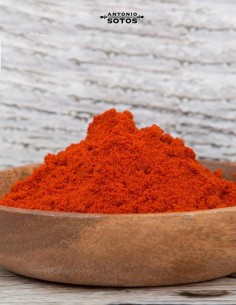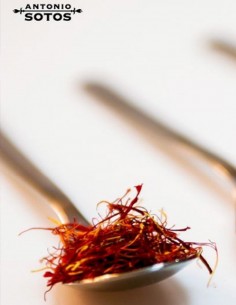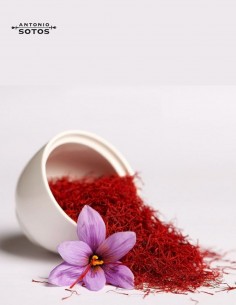- Antonio Sotos
- Products
- 0 likes
- 0 comments

There is no doubt saffron is the oldest and most used spice by the Human Being. The cultivation of this plant is closely related to the most cultured and refined civilizations in the Oriental World. Therefore, saffron discover y in Occidental countries, is connected to the prog ressive displacements of people, from East to West, which made up the different cultures in the Mediterranean Basin. Nowadays is considered as the finest and most delicate of spices. The saffron has endless gastronomic qualities giving a deep and intense aroma, flavour and colour to your dishes.

Located in La Mancha region, ANTONIO SOTOS, S.L. is the fourth generation in a family business with over 100 years experience dealing with saffron.
Established in 1912, it soon focused its business overseas, being one of the pioneer companies in the foreign trade of saffron.Nowadays, thanks to our experience and the efforts we have made, we can proudly say our products are distributed in more than 30 different countries, in 4 different continents such us Europe, Asia, America and Oceania.
Our brands “ANTONIO SOTOS GOURMET” and “SAFFROMAN” are recognized all around the world as a sign of quality and reliability.
Manufacture and supervision of our products is done under the strictest rules of quality and control, having obtained the International quality Certifications in IFS (International Food Standards), BRC (British Retail Consortium) and ISO 9001:2008 for handling, packing and commercialization of saffron.
Our mission is to foment the use of saffron worldwide promoting our products and offering to our customers the best quality adapted to their needs, at a competitive price and with an exclusive attention.
Our vision: we are growing to become one of the worldwide saffron sector leaders with a firm focus on the future.
TRADITION
Its scientific name (Crocus Sativus L.) comes from kroke, a word of Greek origin meaning filament and Sativus means cultivable.
It is a bulbous and perennial plant which belongs to the Iridaceae family. The flower is characterized for having an intensive purple colour and the stamens are yellow and there are three red stigmas. These stigmas are joined to the base of the flower by the style and once removed, toasted and dried become what we know as saffron.
CULTIVATION
For healthy growth and development, the plant requires a continental climate, being able to resist high temperatures and intensive cold. The plant does not need too much water, although there are 2 seasons during the year, spring and autum, where the plant requires more humidity-in spring for favouring bulb formation and at the beginning of autumn to help flowering. The planting of bulbs is done between June and September.
HARVESTING
Harvesting time is at the end of October, beginning of November. The rose blooms at dawn and must be picked from the soil instantly. Lengthy exposure to light must be avoided, otherwise the flower withers and the stigmas lose colour and aroma.
PEEL
Afterwards, the stigmas are taken out from the rest of the flower. This work done by hand is called “monda” or “esbrinar” and is considered as the most delicate part of the whole process.
DRYING
Later, the stigmas are toasted and dried. The aim is to keep the saffron in perfect conditions. Remember that saffron is basically made of water and presents a high grade of humidity. We should obtain 200 grams of saffron ready for consumption with every kilogramme of natural stigmas.
CONSERVATION
To conclude, the saffron must be kept in a dry place and protected from the light.
CULINARY QUALITIES
Saffron (Crocus Sativus) is regarded as the finest and delicate spice. The gastronomic qualities of saffron are endless giving your dishes a deep and intense flavor, aroma and color.
QUALITY AND GUARANTEE
Our main challenge and objective is to obtain top quality in our products and total customer satisfaction.
In order to fulfil this aim ANTONIO SOTOS, S.L. has developed a policy of quality control and supervision of each and every process carried out, from the saffron entering our warehouse, to the product finally reaching the consumer.
Manufacture and supervision of our products is done under the strictest rules of quality control, having obtained the International quality Certifications in IFS (International Food Standard), BRC (British Retail Consortium) and ISO 9001:2008 for handling, packaging and commercialization of saffron.
Every process complies with the manual and regulation HACCP being permanently advised, assessed and audited by specialized companies in agroalimentary quality, and regulary reviewed by the Ministry of Health.
GUARANTEE
ANTONIO SOTOS, S.L. guarantees accountability concerning the origin and composition of its products. To guarantee that all our products entirely comply with European and International standards, as well as with the level and quality required by our customers, the saffron is analyzed by a specialised Official Laboratory approved by the Spanish Ministry of Economy, Commerce and Fraud.
If the results of the analysis do not fulfill our expectations or our customers requirements, the batch will be immediately returned to its source.
TRACEABILITY
It is as important for our company to know the accurate origine of the raw material, as for our customer to know the history of the saffron he is buying.
Traceability allows us to know at every moment and quickly, the exact origin and composition of each and every one of our product.
All the saffron entering our stores, as well as the final product destined to our customers, receive a different number for each batch, which should allows for its prompt identification.
HYGIENE
From the moment saffron is purchased from the farmer, to the moment it finally reaches the consumer, saffron undergoes numerous hygiene controls.
Our suppliers of raw material and packaging, as well as the tranport companies we work with, have been strictly evaluated on questions of quality and hygiene.
Our staff participate in information and training programmes in this area, being perfectly aware of the importance of hygiene in a working environment.
CERTIFICATES














Comments (0)